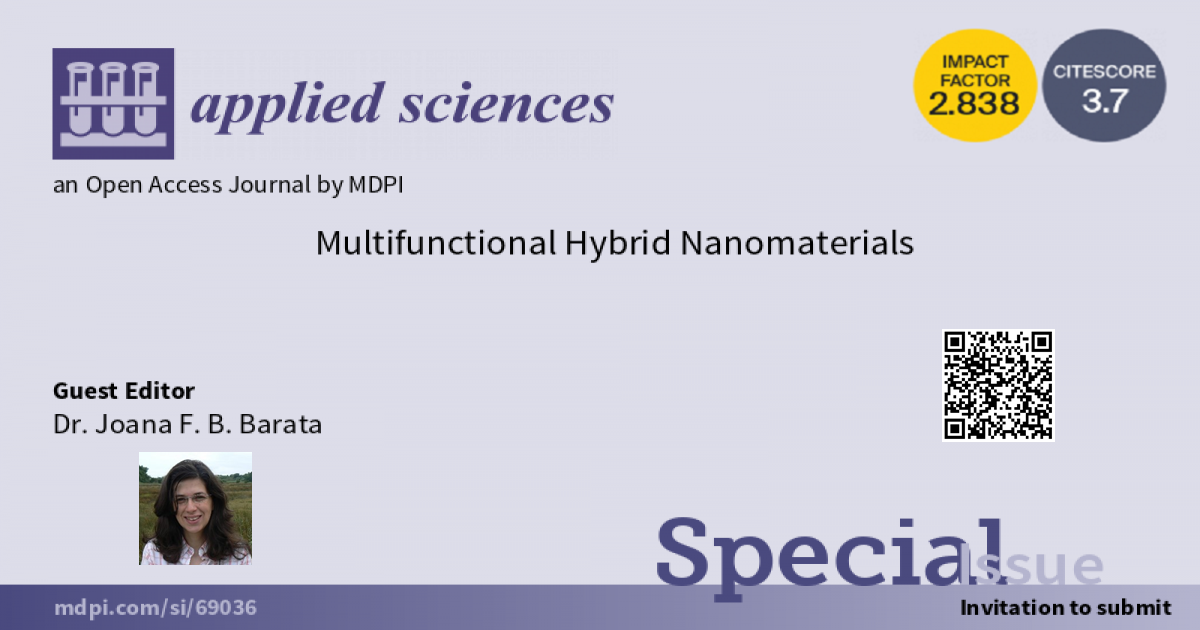Multifunctional Hybrid Nanomaterials
A special issue of Applied Sciences (ISSN 2076-3417). This special issue belongs to the section "Nanotechnology and Applied Nanosciences".
Deadline for manuscript submissions: closed (31 December 2022) | Viewed by 15100

Special Issue Editor
Interests: photodynamic therapy; nanoparticles; corroles; synthesis
Special Issues, Collections and Topics in MDPI journals
Special Issue Information
Dear Colleagues,
Nanomaterials play a crucial role in multiple areas, such as chemical and biological sensing, catalysis, imaging, and diagnosis, among others. Moreover, the preparation of multifunctional hybrid nanomaterials based on inorganic nanoparticles and organic dyes can lead to new insights and further progress in a wide range of applications. In fact, the synergistic effect of the combination of the two entities affords new materials with unique and key multifunctional physicochemical properties to be used as sensors and photosensitizers, among others.
The design, synthesis, and evaluation of high-performance multifunctional hybrid nanomaterials are quite challenge, with still a long way to go.
The main objective of this interdisciplinary Special Issue of Applied Sciences is to bring together, at an international level, high-quality papers concerning the synthesis, characterization, and application of multifunctional hybrid nanoparticles in several areas.
In this Special Issue, submissions in the form of full-length articles, reviews, communications, and mini reviews on nanoscience/technology at the interface of engineering, biology, physics, chemistry, and materials are encouraged for submission.
Dr. Joana F. B. Barata
Guest Editor
Manuscript Submission Information
Manuscripts should be submitted online at www.mdpi.com by registering and logging in to this website. Once you are registered, click here to go to the submission form. Manuscripts can be submitted until the deadline. All submissions that pass pre-check are peer-reviewed. Accepted papers will be published continuously in the journal (as soon as accepted) and will be listed together on the special issue website. Research articles, review articles as well as short communications are invited. For planned papers, a title and short abstract (about 100 words) can be sent to the Editorial Office for announcement on this website.
Submitted manuscripts should not have been published previously, nor be under consideration for publication elsewhere (except conference proceedings papers). All manuscripts are thoroughly refereed through a single-blind peer-review process. A guide for authors and other relevant information for submission of manuscripts is available on the Instructions for Authors page. Applied Sciences is an international peer-reviewed open access semimonthly journal published by MDPI.
Please visit the Instructions for Authors page before submitting a manuscript. The Article Processing Charge (APC) for publication in this open access journal is 2400 CHF (Swiss Francs). Submitted papers should be well formatted and use good English. Authors may use MDPI's English editing service prior to publication or during author revisions.
Keywords
- nanoassemblies
- conjugation
- metallic nanoparticles
- QDs
- macrocycles
- dyes
- energy transfer
- photodynamic properties
- sensor
Benefits of Publishing in a Special Issue
- Ease of navigation: Grouping papers by topic helps scholars navigate broad scope journals more efficiently.
- Greater discoverability: Special Issues support the reach and impact of scientific research. Articles in Special Issues are more discoverable and cited more frequently.
- Expansion of research network: Special Issues facilitate connections among authors, fostering scientific collaborations.
- External promotion: Articles in Special Issues are often promoted through the journal's social media, increasing their visibility.
- e-Book format: Special Issues with more than 10 articles can be published as dedicated e-books, ensuring wide and rapid dissemination.
Further information on MDPI's Special Issue policies can be found here.





